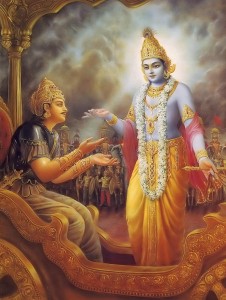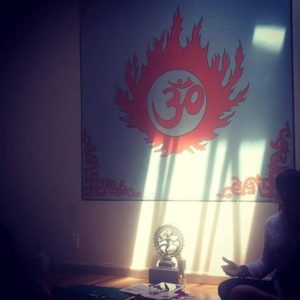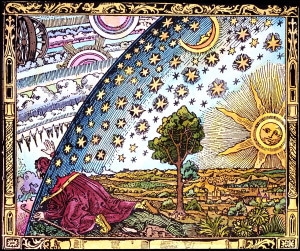We’ve been listening to Handel’s Messiah and most of the text is from the book of Isaiah – we just heard “He shall feed his flock like a shepherd” which has the line: “take His yoke upon you…” And then we heard the song: “His yoke is easy and His burden is light.”
Yoga is sometimes thought of as a kind of ‘yoking’ or harnessing. You will see puns in the yogic texts like “yoke your mind to the prana” or “yoke the inner energy to the attainment of the crown center.”
We see lots of use of this metaphor in the Bhagavad Gita. The Bhagavad Gita takes place on a battlefield and concerns the conversation between the warrior, Arjuna, and his charioteer, Lord Krishna. Right there on the battlefield, Krishna teaches Yoga. He explains that yoga is not a practice confined to a certain time or space but something that is practiced with every action. He explains that yoga is a kind of orientation toward action in the world.
Krishna uses the word “yukt” which means yoked, united, and it is the root of the word “Yoga.” And Krishna says that a person’s everyday acts can be yoked or harnessed for the goal of enlightenment, if you learn to devote the action to God, who is the embodiment of love. He is saying that everything we do, every action can be transformed into yoga by yoking the action, dedicating it, to the service of the One. The mundane things we do can be harnessed as vehicles to the state of union with God. Buying tea and muffins at the bakery? Offer the action with love to your higher power. Here is a secret: there is no action that cant be offered to That. Remember, Arjuna is about to engage in a terrible battle. Even things we feel are bad, lazy and selfish can be “yukt.” If offered consciously and with humility, it is a real surrender – especially the acts we may feel to be unworthy. Krishna says this skill of yoking can be accomplished by “Abhyasa” (practice) and “Vairagya” (renunciation), and that it brings liberation, the state of absolute Joy. When we work with yogic postures we are practicing this orientation to action. We set our intention to yoke the action to the goal: Joy, liberation, and when we do this simple cognitive gesture, practice it, it becomes habitual, the default setting, and we are able to reap bliss from simple mundane actions.
There is a crucial relationship between vairagya – renunciation – and absolute Joy. Christ likened the “Kingdom of Heaven” which is a state of awareness, to a pearl of great price. That pearl is simple joy,which is purchased with everything you ‘have’. Only one who totally lets go of attachment can experience unconditional joy. People dont understand that this is not a kind of happiness that is dependent upon something. It is freedom from expectations, and surrender. This is possible, easy even, through love.
A salient point here is that detachment is not the same as apathy or negligence. The olympics are coming up and i always remember one time in 2002 when the ice skater Sara Hughes was competing. She was young, and during the program she calculated that it would be virtually impossible for her to win the event, but she thought, i dont have to worry about winning, i can come back in four years, I will just go out and skate for the love of it. And so her action was in a sense full of “vairagya,” renunciation of the results, and because of that, it contained a freedom that perfected her performance and she won the gold! She had both ingredients of yoga going: “Abhyasa,” practice, and “Vairagya,” joyful renunciation. The famous quote from the Isha Upanishad is Tena tyaktena bhunjitha which means, “renounce the world to enjoy it.” Yoga is the marriage of passion and renunciation.
This is the time of year when everyone says Rejoice, Rejoice! (as in the piece we heard from Handel’s Messiah) and sometimes this leads to its opposite because people ask, am I rejoicing? And we say, no, because I’ve got so many things that are wrong – it’s terrible, things not going as i had planned, I’m aging, I’m broke and I’m expected to spend money, by the way… so we find that we’re asked to rejoice – and it ain’t that easy. So yoga is the skill of rejoicing in our reality “as is,” and rejoicing is unconditional.
There are so many levels of peace –
Peace is the consort of Joy, and there are more and more exquisite layers of peace that can be experienced. But we have to make our awareness exquisite in order to perceive them – this is why we do these things with our breath and our consciousness: to sharpen and hone our perception so we can extract a delicate thread of bliss from our daily experiences.
We said we would “yoke” our actions, our asanas, to the goal and we get confused, confounded. What was it again? “Oh yeah, release the results and expectations…how do i do that again…?” Well, here is the easiest thing: Just yoke the prana to love, adore the breath, and by infusing your being with love, which is the highest principle, you will find you have arrived at unconditional Joy. The yoke of love is easy, and its burden, is light.











Leave a Reply